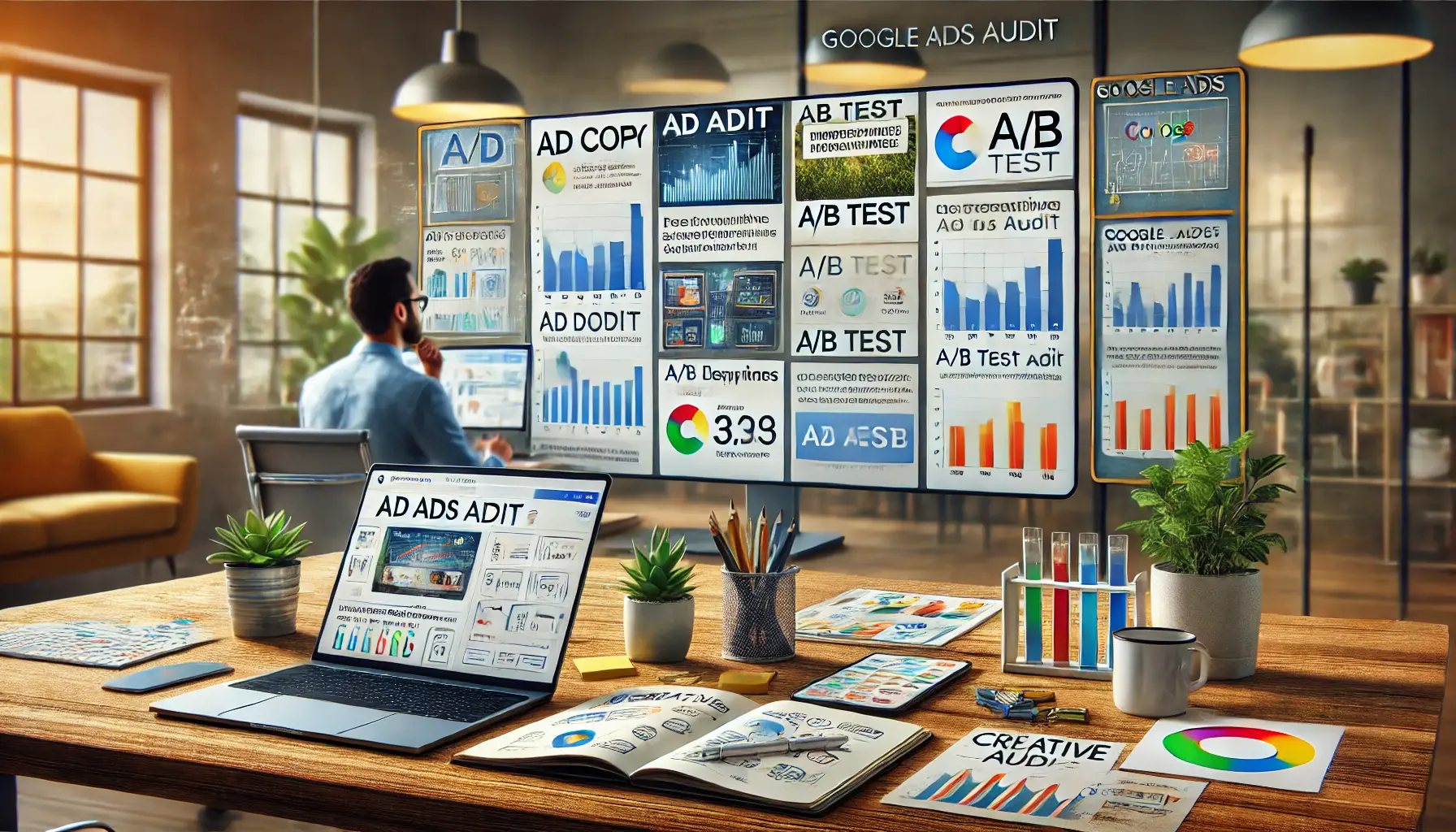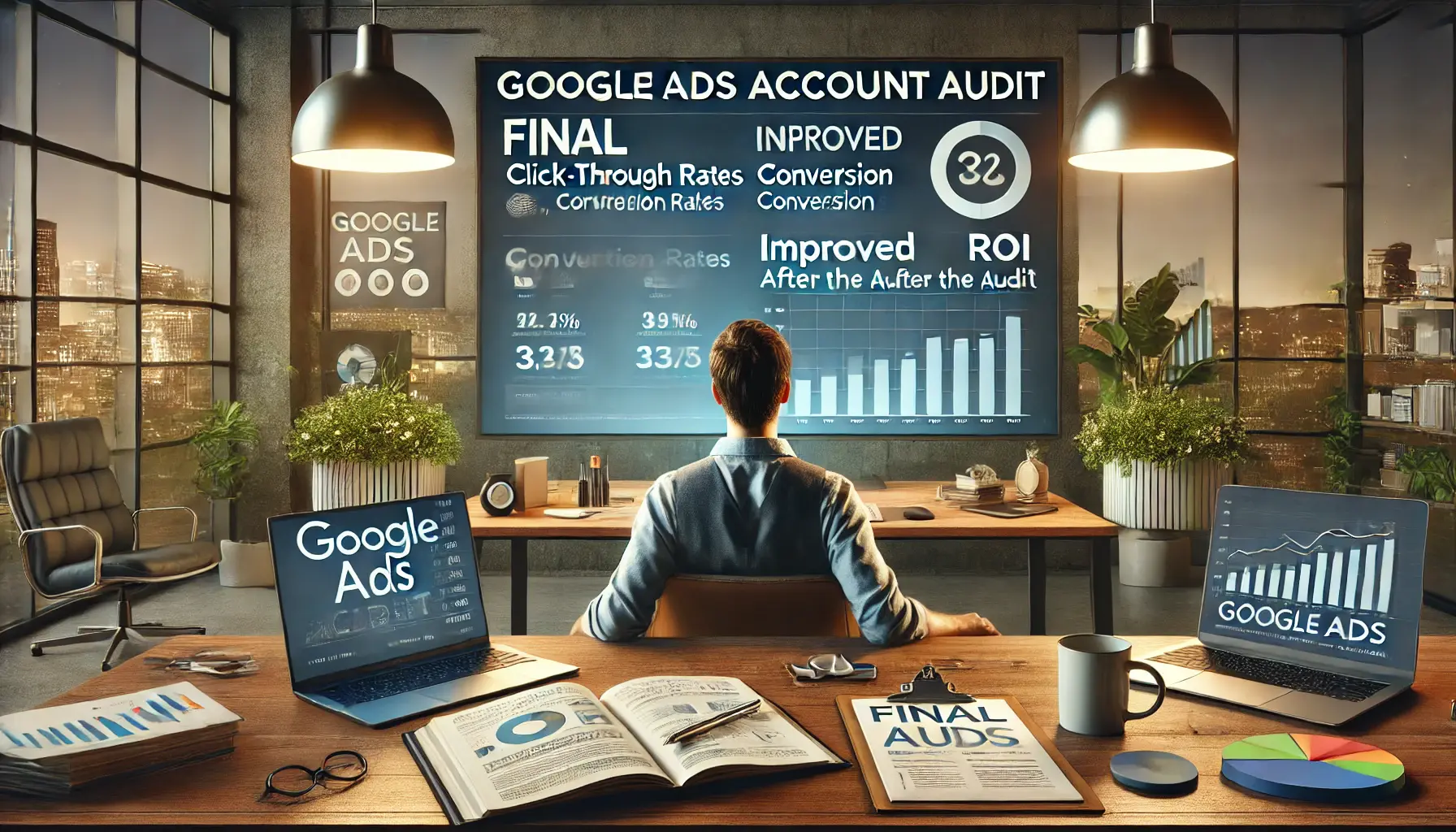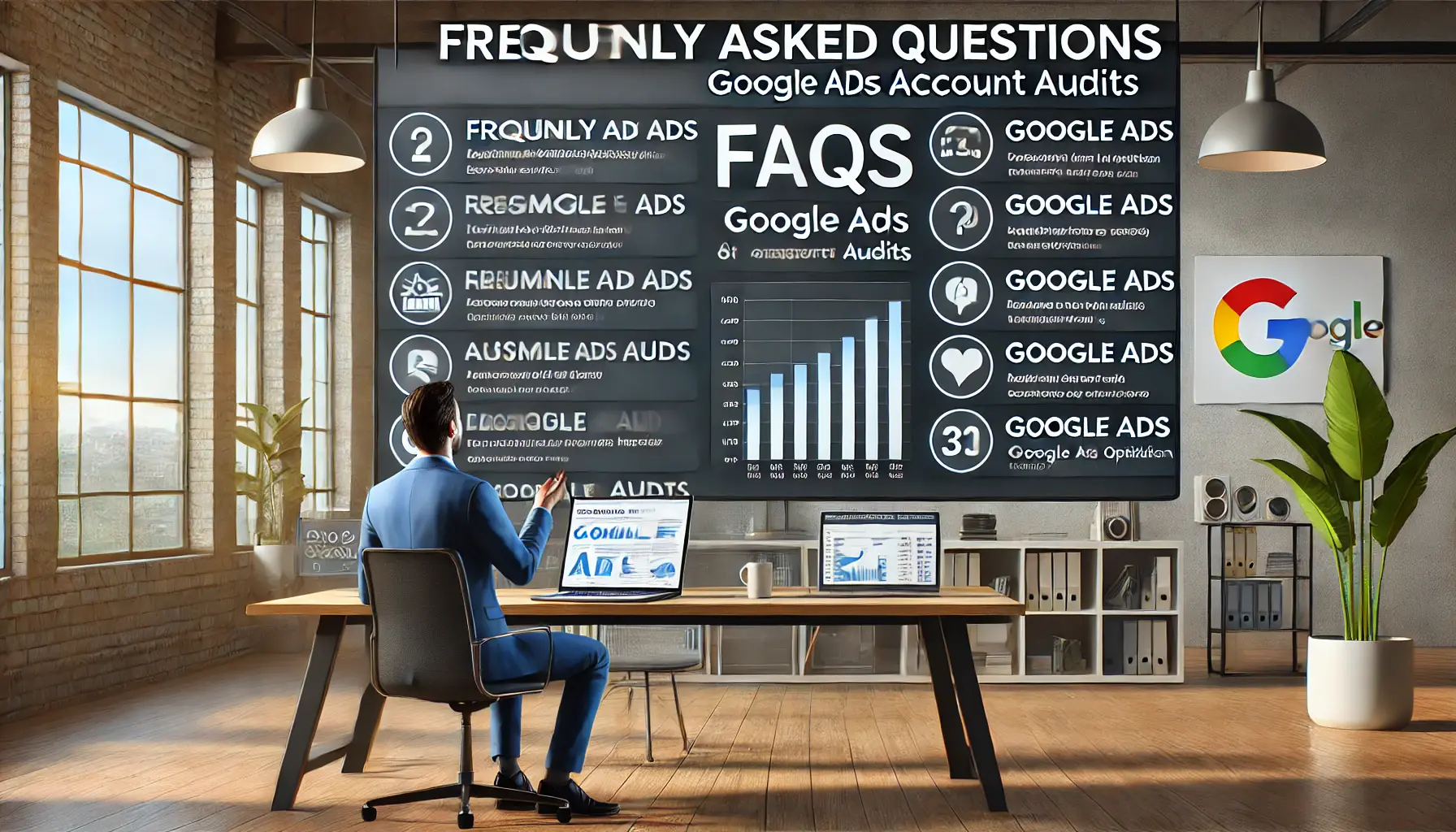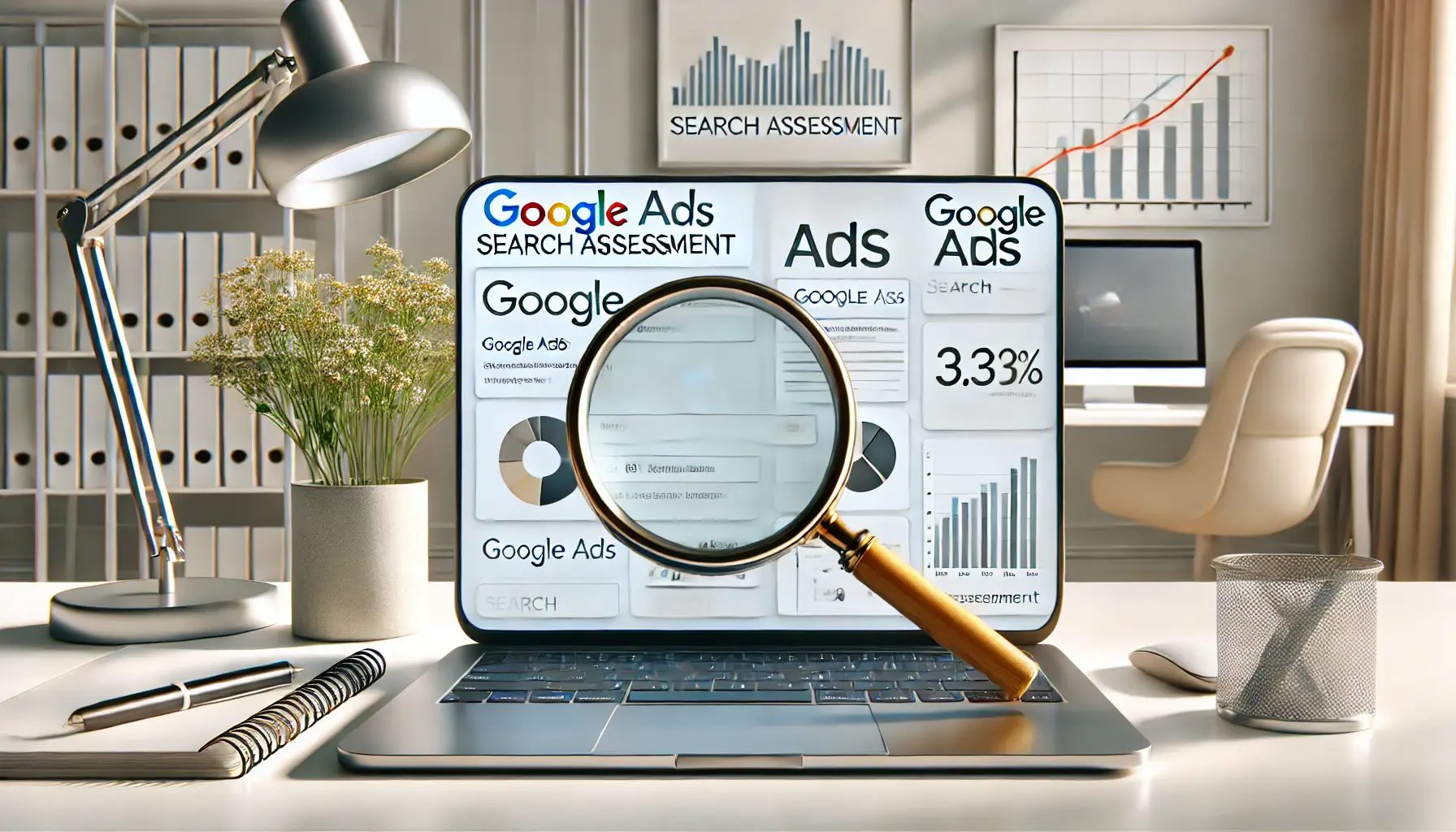How long has it been since you conducted a thorough Google Ads account audit?
If it’s been some time, you’re probably losing money.
Google Ads is a robust source of traffic for achieving your business goals, but without regularly auditing your campaigns, inefficiencies can creep into these channels, causing wasted ad spend and missed opportunities.
A well-structured Google Ads account audit is essential to identify issues, optimize performance, and ensure you get the best return on investment.
This guide will walk you through every step to help you maximize your ad spend and improve campaign results.
- Understanding the Importance of a Google Ads Account Audit
- Preparing for Your Google Ads Account Audit
- Important Elements to Look at When Conducting a Google Ads Account Audit
- Analyzing Performance Metrics and Data in Your Google Ads Account Audit
- Implementing Audit Findings and Monitoring Results in Your Google Ads Account
- Conclusion from Conducting a Google Ads Account Audit
- Frequently Asked Questions About Google Ads Account Audits
Understanding the Importance of a Google Ads Account Audit
A Google Ads account audit isn’t just a routine check—it’s a critical process that can reveal hidden opportunities for growth and efficiency.
With ever-evolving market trends, consumer behavior, and competition, staying ahead requires consistent evaluation of your advertising strategies.
Let’s explore why conducting an audit is essential for your business.

Analyzing campaign performance metrics to ensure success through regular audits.
Why Regular Audits Are Essential for Campaign Success
Your Google Ads account is a dynamic system.
Over time, algorithms evolve, user behavior changes, and sometimes even your offerings shift, which can impact performance.
Regular audits help you:
- Identify inefficiencies: Spot underperforming campaigns or ad groups that drain your budget without delivering results.
- Optimize resource allocation: Redirect your budget to high-performing areas for better ROI.
- Keep yourself updated: Ensure your strategies align with current industry standards and Google Ads updates.

Identifying inefficiencies and challenges during Google Ads audits.
Common Problems Uncovered Through Audits
An audit can uncover problems that may not be immediately visible.
Some common issues include:
- Irrelevant keywords: Keywords that no longer meet your targets or align with your audience.
- Poor ad copy: Ads that fail to attract users or effectively convey your value proposition.
- Improper tracking: Conversion tracking errors that lead to inaccurate data and poor decision-making.

Achieving success through a well-executed Google Ads audit.
Benefits of a Well-Executed Google Ads Audit
When executed properly, a Google Ads account audit can transform your campaigns.
Benefits include:
- Improved performance: A refined strategy focused on what works best.
- Cost savings: Eliminating wasted ad spend and reallocating funds effectively.
- Better insights: Gaining a deeper understanding of your audience and their behavior.
Regularly auditing your Google Ads account ensures your campaigns are efficient, impactful, and aligned with your business goals.
In the next section, we’ll discuss how to prepare for a successful audit and set the stage for meaningful improvements.
Regular audits help uncover inefficiencies and reveal opportunities for campaign optimization.

Strategic preparation for a comprehensive Google Ads account audit.
Preparing for Your Google Ads Account Audit
Starting your Google Ads account audit requires thorough preparation to ensure a comprehensive and effective review.
With proper groundwork, you can streamline the audit process and uncover actionable insights to improve your campaigns.
Let’s get started on the essential steps you need to prepare for your Google Ads account audit.

Defining clear goals for a successful Google Ads audit.
Set Clear Objectives
It’s important to set clear objectives for your audit.
Define what you hope to achieve, such as:
- Improving conversion rates: Focus on strategies that drive more successful actions.
- Reducing cost per click: Identify ways to optimize budget allocation.
- Enhancing ad relevance: Ensure your ads align closely with your audience’s needs and interests.
Having well-defined goals will guide your audit and keep the focus on areas that impact your business outcomes.

Preparing essential tools and data for a thorough Google Ads audit.
Gather Necessary Data and Tools
Collect all the required data and tools before starting the audit.
Make sure you have access to:
- Your Google Ads account for detailed campaign data.
- Google Analytics to analyze user behavior and conversion paths.
- Any third-party platforms integrated with your campaigns.
Having these resources readily available will facilitate a thorough analysis of performance metrics and user behavior.

Setting a realistic timeline for effective Google Ads audit planning.
Establish a Realistic Timeline
Setting up a feasible timeline is crucial.
Depending on the size and complexity of your account, allocate adequate time to analyze each component without rushing.
A well-paced audit ensures a better and more precise evaluation.
By laying this groundwork, you prepare for a detailed audit that can significantly improve your Google Ads campaigns.
The sections below provide a step-by-step outline to help you review and optimize your account effectively.
Define clear objectives and gather the necessary tools to ensure a successful audit process.

Examining critical elements for a comprehensive Google Ads account audit.
Important Elements to Look at When Conducting a Google Ads Account Audit
Carrying out a full Google Ads account audit requires examining a number of key elements to optimize performance.
By systematically reviewing each of these areas, you can uncover opportunities for improvement and implement strategies to enhance your campaigns.
Let’s explore the most important elements to focus on during your audit.

Optimizing account and campaign settings during a Google Ads audit.
1. Account and Campaign Settings
Begin by assessing your account and campaign settings to confirm they align with your advertising objectives.
Key areas to review include:
- Conversion Tracking: Ensure that conversion tracking is enabled and accurately recording desired actions. Proper tracking allows for precise measurement of campaign effectiveness.
- Network Targeting: Segment the Search and Display Networks into separate campaigns. Running ads across both networks in one campaign can lead to inefficiencies due to differing user intents.
- Ad Scheduling: Review performance data to identify high-performing days and times, and optimize ad schedules to maximize impressions during these periods.
- Location Targeting: Verify that your ads are targeting the correct geographical areas relevant to your business and exclude locations that are not pertinent to your objectives.

Ensuring effective account structure and organization during a Google Ads audit.
2. Account Structure and Organization
A well-organized account structure facilitates efficient management and reporting.
Examine the following aspects:
- Campaign Organization: Structure campaigns around specific products, services, or goals to maintain clarity and focus.
- Ad Group Relevance: Group similar keywords within ad groups to ensure ads are highly relevant to user searches, improving Quality Scores and performance.

Refining keyword targeting and match types for optimal ad performance.
3. Keywords and Match Types
Keywords are the foundation of your campaigns.
Evaluate your keyword strategy by:
- Analyzing Search Terms: Review the search terms report to identify which queries trigger your ads and refine your keyword list to include high-performing terms.
- Negative Keywords: Add irrelevant or low-performing search terms as negative keywords to prevent ads from appearing on unrelated searches, reducing wasted spend.
- Match Types Optimization: Use a strategic combination of match types (broad, phrase, exact) to balance reach and relevance based on campaign goals.

Optimizing ad copy and creative elements for better campaign performance.
4. Ad Copy and Creative Elements
Compelling ad copy is essential for attracting clicks and conversions.
Evaluate your ads by:
- Ensuring Relevance: Align ad copy with targeted keywords and user intent to increase engagement and Quality Scores.
- Utilizing Ad Extensions: Implement appropriate ad extensions (sitelinks, callouts, structured snippets) to provide additional information and enhance ad visibility.
- Ad Headline and Description Variations: Test different variations of ad headlines, descriptions, and calls to action to determine which combinations perform best for your target audience.

Enhancing landing page experience for improved campaign results.
5. Landing Page Experience
The user experience on your landing pages significantly impacts campaign success.
Assess landing pages by:
- Relevance Assessment: Ensure that landing page content aligns closely with the ad’s message and meets user expectations.
- Load Time Optimization: Optimize page load speeds to minimize bounce rates and enhance user satisfaction.
- Mobile Responsiveness: Verify that landing pages are responsive and provide a seamless experience across all devices.
By thoroughly examining these components in your Google Ads account audit, you can identify areas for improvement and execute optimization strategies effectively.
In the next section, we will focus on analyzing performance metrics and data to further enhance your advertising efforts.
- Account settings like conversion tracking and ad scheduling are crucial.
- Ensure proper keyword usage and relevance for better performance.
- Optimize ad copy and landing pages to enhance user experience and conversions.

Examining key performance metrics for optimizing Google Ads campaigns.
Analyzing Performance Metrics and Data in Your Google Ads Account Audit
To effectively optimize your Google Ads campaigns, it’s essential to analyze key performance metrics and data during your account audit.
This analysis provides insights into what’s working and what needs improvement, enabling data-driven decisions to enhance your advertising efforts.
Let’s explore the critical metrics to focus on during your audit.

Analyzing click-through rate (CTR) trends to optimize Google Ads performance.
1. Click-Through Rate (CTR)
CTR measures the percentage of users who click on your ad after seeing it.
A higher CTRClick-Through Rate, a metric that shows the percentage of users who click on an ad after viewing it. indicates that your ads are relevant and engaging to your audience.
To improve CTR:
- Optimize Ad Copy: Craft compelling headlines and descriptions that resonate with your target audience.
- Utilize Ad Extensions: Implement sitelinks, callouts, and structured snippets to provide additional information and encourage clicks.

Optimizing conversion rates through data analysis in a Google Ads audit.
2. Conversion Rate
Conversion Rate is the percentage of clicks that result in a desired action, such as a purchase or a sign-up.
To increase conversion rates:
- Align Ads with Landing Pages: Ensure that your ad messaging is consistent with what’s presented on the landing page.
- Improve Landing Page Experience: Optimize for speed, mobile-friendliness, and clear calls to action.

Managing cost per click (CPC) for optimized advertising spend in a Google Ads audit.
3. Cost Per Click (CPC)
CPC indicates the average amount you pay for each click on your ad.
To manage CPCCost Per Click, the average amount paid for each click on an ad. effectively:
- Refine Keyword Selection: Focus on high-performing keywords and consider pausing those with low performance.
- Adjust Bidding Strategies: Utilize automated bidding strategies to optimize bids based on performance goals.

Optimizing Quality Score for improved Google Ads performance.
4. Quality Score
Quality Score is Google’s rating of the relevance and quality of your ads, keywords, and landing pages.
A higher Quality ScoreA Google Ads metric that measures the relevance and quality of your ads, keywords, and landing pages. can lead to lower CPCs and better ad positions.
To improve Quality Score:
- Enhance Ad Relevance: Align your ad copy closely with targeted keywords.
- Optimize Landing Pages: Ensure they provide valuable content and a positive user experience.

Optimizing Return on Ad Spend (ROAS) for better advertising investment outcomes.
5. Return on Ad Spend (ROAS)
ROAS calculates the revenue gained for each dollar spent on advertisements.
To improve ROASReturn on Ad Spend, a metric that measures revenue generated for each dollar spent on advertising.:
- Analyze Campaign Performance: Identify and allocate more budget to high-performing campaigns.
- Reduce Wasted Spend: Use negative keywords and adjust targeting to minimize unproductive clicks.
Analyzing these performance metrics during your Google Ads account audit will provide a clear understanding of areas that need improvement and where to invest for optimal campaign performance.
In the next section, we will discuss how to implement improvements and monitor progress for sustained advertising effectiveness.
Focus on metrics like CTR, CPC, and ROAS to identify actionable insights and drive better outcomes.

Implementing audit findings and monitoring improvements in Google Ads account performance.
Implementing Audit Findings and Monitoring Results in Your Google Ads Account
After conducting a comprehensive Google Ads account audit, the next crucial step is to implement the identified improvements and continuously monitor the results.
This process ensures that your campaigns evolve and adapt, leading to sustained performance and a higher return on investment.
Let’s delve into how you can effectively apply audit findings and keep track of your campaign’s progress.

Prioritizing and implementing changes for optimizing Google Ads campaigns.
1. Prioritize and Implement Changes
Start by categorizing the audit findings based on their impact and urgency.
Focus on high-impact areas that align closely with your business objectives.
For instance:
- Optimize Underperforming Keywords: Pause or adjust bids on keywords with low Quality Scores or high costs per conversion.
- Revise Ad Copy: Update ads to enhance relevance and engagement, incorporating best practices for compelling messaging.
- Optimize Landing Pages: Increase page speed, mobile responsiveness, and alignment of content with ad messages to increase conversion rates.

Setting measurable goals for successful Google Ads campaign optimization.
2. Set Measurable Goals
Set well-defined, measurable objectives to assess the success of the changes made.
These objectives may include:
- Click-Through Rate (CTR): Achieve a specific percentage growth in CTR within a defined time frame.
- Lower CPA: Establish a goal of reducing CPA by a specific percentage or amount.
- Increase Conversion Rate: Achieve a tangible increase in the number of visitors converting on your site.

Monitoring performance metrics to optimize Google Ads campaigns.
3. Monitor Performance Metrics
Leverage Google Ads reporting tools to regularly monitor key performance indicators (KPIs).
Keep a close eye on metrics such as:
- Impressions and Clicks: Observe changes in visibility and engagement.
- Quality Score: Monitor improvements in ad relevance and estimated click-through rates.
- Conversion Metrics: Track conversions and conversion rates to evaluate the performance of landing pages and funnels.

Conducting A/B testing to optimize Google Ads performance.
4. Conduct A/B Testing
Implement A/B tests to determine which strategies yield better results in various scenarios.
For example:
- Ad Variants: Test different headlines, descriptions, and calls to action to identify what resonates most with your audience.
- Landing Page Designs: Experiment with various layouts, images, and content combinations to achieve higher conversions.

Scheduling regular reviews to optimize Google Ads campaigns over time.
5. Schedule Regular Reviews
Set up periodic evaluations of your campaigns to ensure ongoing optimization.
Regular reviews help in:
- Identifying New Opportunities: Stay ahead by adapting to market trends and changes in consumer behavior.
- Ensuring Budget Efficiency: Reallocate funds from underperforming areas to high-performing ones to maximize ROI.
Through consistent implementation of audit recommendations and diligent monitoring of your Google Ads account, you can establish a cycle of continuous improvement.
This approach not only enhances current campaign performance but also creates a robust foundation for future advertising initiatives.
Prioritize impactful changes, set measurable goals, and conduct A/B testing to ensure sustained improvements.

Achieving success and optimizing Google Ads campaigns after completing an account audit.
Conclusion from Conducting a Google Ads Account Audit
Conducting a Google Ads account audit is one of the most crucial activities for optimizing advertisement campaigns for greater efficiency and effectiveness.
By addressing key areas and implementing strategic changes, businesses can uncover opportunities, reduce wasted ad spend, and enhance overall campaign performance.
Let’s summarize the major steps discussed in this article.

Identifying inefficiencies and opportunities for improvement through a Google Ads audit.
Why Conduct an Audit
A Google Ads account audit is not just a routine check; it is a strategic process that aligns campaigns with business goals and ensures relevance in an ever-changing digital advertising landscape.
Regular audits help businesses stay competitive, optimize budgets, and identify growth opportunities.

Structured preparation for a successful Google Ads account audit.
Preparation is the Foundation
Effective preparation sets the tone for a successful audit.
Defining clear objectives, gathering necessary tools and data, and setting a realistic timeline ensures a streamlined and productive process.
This foundational step allows for a structured approach to uncovering and addressing issues effectively.

Analyzing key areas for a comprehensive Google Ads account audit.
Key Areas to Audit
Thoroughly examining critical components of your Google Ads account is essential.
These include:
- Account and campaign settings to ensure alignment with advertising objectives.
- Account structure and organization for efficient management.
- Keyword performance and match types to optimize relevance and reduce wasted spend.
- Ad copy and creative elements to enhance engagement and improve Quality Scores.
- Landing page experience to boost conversions and user satisfaction.

Analyzing key performance metrics for optimizing Google Ads campaigns.
Analyzing Performance Metrics
An audit is incomplete without a detailed analysis of performance metrics.
Metrics such as CTR, CPC, Quality Score, and ROAS are primary indicators that help interpret campaign effectiveness.
These metrics enable data-driven decisions to refine and improve your campaigns further.

Implementing changes and monitoring progress to optimize Google Ads campaigns.
Change Implementation and Progress Monitoring
Finally, the findings from the audit should be implemented and monitored for their impact over time.
Prioritizing high-impact changes, setting measurable goals, and conducting A/B testing ensure that optimizations deliver results.
Regular reviews and adjustments establish a cycle of continuous improvement.
This structured approach will transform your Google Ads campaigns into an efficient and effective marketing channel.
A well-executed Google Ads account audit not only improves immediate performance but also lays the foundation for long-term advertising success.
A well-structured audit aligns your campaigns with business objectives and fosters continuous improvement for long-term success.

Addressing frequently asked questions about Google Ads account audits.
Your campaigns can be managed by an agency specialized in Google Ads, check out our service page.
Frequently Asked Questions About Google Ads Account Audits
Having a Google Ads account audit can raise several questions.
Here are some common inquiries to help guide you through the process.
A Google Ads account audit is an in-depth review of your PPCPay-Per-Click, a digital advertising model where advertisers pay each time a user clicks their ad. campaigns to identify areas for improvement and optimization.
Regular audits uncover inefficiencies, reduce wasted ad spend, and align campaigns with current business objectives.
It is recommended to audit your Google Ads account at least once every 3-6 months, depending on account size and activity.
Key components include reviewing account structure, campaign settings, keywords, ad copy, landing pages, and performance metrics.
Analyze performance data to find underperforming keywords, irrelevant placements, and ineffective ads that don’t contribute to your goals.
Tools like Google Analytics, Google Ads’ built-in reports, and third-party audit tools can provide valuable insights.
Monitor key performance indicators such as CTR, conversion rate, and ROI to assess the impact of implemented changes.
Yes, by optimizing keywords, ad relevance, and landing page experience, an audit can enhance your Quality Score.
If you’re unfamiliar with the process or lack time, hiring a professional can ensure a thorough and effective audit.












